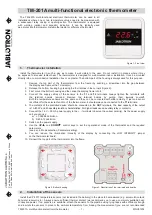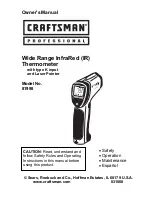
Troubleshooting
9
Troubleshooting
9
cont.
Symptom:
HI is shown in the thermostat
display where the room temperature is
normally displayed.
Potential Solutions:
The temperature
sensed by the thermostat is higher than the
99˚ F (37˚ C) upper limit of the thermostat’s
display range. The display will return to
normal after the sensed temperature lowers within the 40˚ to 99˚ F (4˚ to 37˚ C)
display range. Turn on the cooling system or use other methods to lower
the temperature.
Symptom:
LO is shown in the thermostat
display where the room temperature is
normally displayed.
Potential Solutions:
The temperature
sensed by the thermostat is lower than the
40˚ F (4˚ C) lower limit of the thermostat’s
display range. The display will return to
normal after the sensed temperature rises within the 40˚ to 99˚ F (4˚ to 37˚ C)
display range. Turn on the heating system to raise the temperature as needed for
comfort within the room.
Symptom:
Cannot program a set point temperature higher than 90˚ F (32˚ C).
Potential Solution:
This is above the normal thermostat temperature setting
range of 45˚ to 90˚ F (7˚ to 32˚ C).
Symptom:
Cannot program a set point temperature lower than 45˚ F (7˚ C).
Potential Solution:
This is below the normal thermostat temperature setting
range of 45˚ to 90˚ F (7˚ to 32˚ C).
Symptom:
Thermostat will not allow set point changes.
Potential Solution:
The Keypad is locked. Press the and key together at the
same time for one second to unlock. See section 7.
Symptom:
Fan continues to run all the time whether the system is on or off.
Potential Solution:
Check that the fan control switch is in the
AUTO
position.
This will allow the fan to run only when the heating or cooling system is turned on
and running.
Check thermostat wiring to make sure that the fan control wiring is connected to
the correct terminals on the wiring terminal block. See section 10.
Symptom:
Fan Runs intermittently or when system is OFF.
Potential Solution:
Fan switch is in Circulate ( ) Mode. See section 4.
Symptom:
The room is too warm or too cold.
Potential Solution:
See section 4 of this manual to verify the current set point
and make any modifications that are necessary.
Symptom:
System turns on prior to the end of a setback period.
Potential Solution:
Thermostat is in Adaptive Recovery Mode. See sections 4
and 7.
®
Symptom:
The word HEAT or COOL is flashing in the thermostat display.
Potential Solution:
This indicates that the heating or cooling system is currently
running. When these systems are not running, HEAT or COOL will not flash.
Symptom:
HEAT or COOL is flashing but the system is not running.
Potential Solution:
The thermostat is telling the heating or cooling system to run,
but the system is not responding. You may need to call your local heating and air
conditioning contractor.
Symptom:
Thermostat does not turn on heating or cooling system.
Potential Solutions:
Check to see if
OFF
is shown in display. This indicates that
the system is turned off at the thermostat. Move the system selector switch to
the
HEAT
or
COOL
position. After the compressor short cycle protection 5-minute
period expires the system should start.
Compressor protection feature may be in effect due to compressor short cycle
conditions. See section 7.
Heating or cooling system may be malfunctioning.
Call a professional service technician immediately to verify system operation.
Symptom:
Thermostat turns on heating instead of cooling or cooling instead
of heating.
Potential Solution:
Check thermostat wiring to make sure that the heating and
cooling stages are connected to the correct terminals on the wiring terminal
block. See section 10.
Symptom:
Thermostat will not follow program set points.
Potential Solutions:
Check current time of day, day of week program settings.
Make sure to verify
AM/PM
indicator is accurately displaying desired time
settings. See section 5.
Check to see if
OFF
is shown in display. This indicates that the system is turned
off at the thermostat. Move the system selector switch to the
HEAT
or
COOL
position. After the compressor short cycle protection period expires the system
should start within several seconds.
Thermostat program is in Extended Hold (Vacation) Mode and
HOLD
is showing in
display. Press
HOLD
or
RETURN
button to release permanent hold and return the
thermostat to normal program operation.
Symptom:
Thermostat turns heating or cooling system on too often or not
often enough.
Potential Solution:
Increase or decrease first stage temperature differential
setting as appropriate to provide the desired performance level. See section 4.
Symptom:
Low battery indicator is shown in thermostat display.
Potential Solution:
Replace batteries immediately to maintain proper system
operation. See section 8.
15
14




































